 German Reich (Estimated 1942-1944)
German Reich (Estimated 1942-1944)
Light Tank – At Least 1 Converted
A mystery mismatch
The R35/T-26 is an R35 chassis with a T-26 conical turret, with a near totally unknown origin. It is, unofficially, named the “Panzerkampfwagen 35R 731(f) mit T-26 Turm” for the purpose of this article, and for ease, R35/T-26 from hereon. There is another vehicle that can be titled “R35/T-26” – one with a round T-26 turret. This article will focus on the conical turreted version, which is likely a German field conversion, whilst the round T-26 turret version will be explored in the Vânătorul de Care R35 article.
R35s were used on the Eastern Front in the early stages of Operation Barbarossa, some as munitionspanzers, but some as security vehicles. This conversion has sparked substantial debate among the Tanks Encyclopedia team as to its origin, date, location, etc. One thing is agreed upon – practically nothing lasts four years on the Eastern Front, so the conversion was most likely done in 1942 or 1943; by which time, the R35 was generally deemed poor for even the role of munitionspanzer. However, the more believable theories place this vehicle in mid/late 1944.
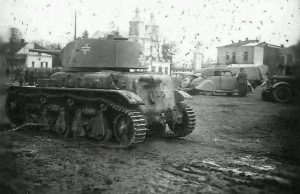
The only known photo of this conversion, having been cleaned up in photoshop (a slightly cropped version of the original can be viewed here). The markings are fairly unremarkable, and there are no soldiers clear enough to identify. The background and scenery is also fairly difficult to identify, not least because it is out of focus, but because it also appears very generic. It is most likely that this is an early/mid war conversion in Yugoslavia.
Context: R35s in Axis use
Large stocks of French tanks were captured by the Germans after the fall of France, and were pressed back into service with their captors. An estimated 843 R35s were captured, 131 of which were used for driver training, and in the Balkans for anti-partisan operations. Many others were converted into SPGs, and some even had parts cannibalized for armored trains, and bunkers. 124 were also used by Italian troops at Gila, 1943. Bulgaria also used 40 between 1943 and 1944 against partisans.
Theories – Origin
Details of R35s on the Eastern Front are unclear, and therefore, this R35 conversion could be in service almost anywhere at any given time after Operation Barbarossa began.
The sole photo of this conical turret version reveals little about the vehicle’s location or date. The architecture seems fairly generic, but shows a semi-urbanized area, characteristic of an Eastern European country such as the Ukrainian SSR, but it could also easily be a small town in Yugoslavia. Attempts to identify the coupe car in the background have failed, although the information that doing so would give would be minor at best. Worse still, there are no soldiers present to identify. The markings on the tank are generic – that of any typical Beutepanzer (which has ruled it out as being a Vânătorul de Care R35 prototype conversion, as Romania never used the balkenkreuz).
Thus, such a lack of evidence can only lead to broad and debatable theories. The main two issues with the theories are: “Would an R35 still be in service by then / there?” and “Would they be able to get a T-26 turret then / there?“. These are questions that are difficult to answer. Assuming that this vehicle is not a Vânătorul de Care R35 prototype (a discussion of which can be found on the respective article), then these are several main theories. The first two are effectively the same – a field conversion by a German sicherung division, and the third theory is that it is fake.
Theory 1. Field Conversion by 7th SS Volunteer Mountain Division Prinz Eugen, Yugoslavia.
The Prinz Eugen used French tanks from 1942 onward, and was stationed in Yugoslavia as an anti-partisan unit. They were heavily armed with captured weapons such as SOMUA S35s, Hotchkiss H39s, Renault R35s, and other foreign machine guns. They also had German field guns, such as the as the 10.5 cm Gebirgshaubitze 40 howitzer and 7.5 cm Gebirgsgeschütz 36 mountain gun.
The Prinz Eugen is reported as having done some field conversions. According to “Tankograd German Panzers & Allied Armour in Yugoslavia in WWII” by Bojan Dimitrijevic, the division operated at least one improvised armored car, thought to be based on a commercial Morris CS8, in 1942 for anti-partisan duties (see photo below). It is, therefore, possible that the T-26/R35 is another conversion by them. Admittedly, this is circumstantial evidence, but, nevertheless, it suggests that they had the capabilities for a field conversion.
There is, however, a major problem with this theory – how the division obtained a T-26 turret. The exact turret is a conical T-26 turret. Only in September, 1944, did the Division come into contact with the Soviet offensive and heavy Yugoslav partisan attacks, where it took heavy casualties. After this, in October, the Division took part in the defense of the Kraljevo Bridgehead, fighting against more Yugoslav partisans. Some theories as to how the turret was obtained are as follows:
1. It is possible that a T-26 was captured from the partisans or the Red Army, and the tank was cannibalized for the conversion. This makes a large assumption that there was still an operational R35 available for the conversion.
2. It is possible that the turret was given to them by another unit. The 21st Waffen Mountain Division of the SS Skanderbeg was incorporated into the Prinz Eugen after its disbandment in November, 1944, who were armed with Italian tanks, and it may be the case that they had a number of captured T-26s, as the M15/42s that the Skanderbeg had was generally deemed unreliable, and may have been replaced with captured T-26s.
3. A T-26 captured from the front lines may have been sent back to the rear for a minor role such as security or munitions transport at any point after the start of Operation Barbarossa. It may have made its way to Yugoslavia, where it was cannibalized for the R35/T-26 conversion.
Theory 2. Field conversion by a different unit.
Few Renault R35 tanks were still on record as being in service by 1943, even though they were probably mostly out of service on the Eastern Front by 1942. Sources vary between 58, and 47 (25 of which were with the Ordnungspolizei). The others were with Panzerbrigade 100 (which served in France), 708th Infantry Division (which served in France), 711th Infantry Division (which served in France, Hungary, Ukrainian SSR, and Czechoslovakia), and the 712th Infantry Division (which served in France, Low Countries, and Poland). The 711th Infantry Division served in Hungary and the Ukrainian SSR, presumably (but this is not confirmed) with those munitionspanzers in 1945. Similarly, the 712th Infantry Division was reformed in Poland, in late 1944. The division was totally unable to deal with the Soviet offensive, and was practically destroyed at the River Oder by January, 1945.
Again, it is plausible that either division (or perhaps any other division which used these munitionspanzers in the early/mid war) tried to increase their firepower by upgrading their munitionspanzer with a captured T-26 turret.
Yugoslavia did have 45 R35s, which saw service against the Germans in April, 1940. According to Bundesarchiv photographs, a handful of R35s were in German service alongside the 11th Panzerdivision for a few days in April, 1941, after which surviving vehicles were used by the Independent State of Croatia, a German puppet state, presumably for security duties. There is no chance that this conversion took place before Operation Barbarossa, because there were no captured T-26s available before then. Not only this, but the R35/T-26 conversion clearly has German markings – Yugoslav markings were different. Whilst 40 R35s were sold to Bulgaria by Germany, Bulgaria had its own tank markings, ruling it out as a possible user of this conversion. Some R35s that were in service with Croatia, to an unknown fate, would also have their own markings.
Theory 3. Fake
As with these little known vehicles, of which only one photo exists, the question as to whether it is a fake or not does arise. The photo is fairly bad quality, but by comparing the lighting, shadows, etc between the turret and chassis, it seems highly doubtful that the photograph is a fake, because these details line up perfectly. If fake, this is a highly professional job. Another problem with it being a fake is that it would be a fairly unremarkable fake – such professional work for something so ‘bland’ is dubious. Apart from which, the original photo was taken from a reputable online wartime photo shop.
Theories – Role
Like with many field conversions, information is scarce, owing to the fact that HQ was not necessarily informed of hasty work done on tanks, particularly Beutepanzers. The tank’s location and date are incredibly important to working out what role it would take on. However, there is a wealth of likely stories for this particular conversion, such as:
1. Designed for direct combat. It is suggested by some that the conversion was meant to fight in regular combat of some kind, whether front-line alongside other tanks, or in rear duties, such as anti-partisan/security. This would mean that the reasons for the conversion are numerous, such as the turret for the R35 being damaged, lack of 37mm munitions, or the 37mm gun being deemed insufficient, so a captured T-26 turret was mounted instead. If it were, as is most likely, made in Yugoslavia then it is more than likely that it is a security vehicle because there would be no need for any other type of vehicle until late 1944, what with the Belgrade Offensive in September.
2. Support vehicle. It has also been suggested that the tank was originally a munitionspanzer that has been converted for artillery observation purposes, with the turret being welded on and not intended to fire, because the turret rings would not match up due to the T-26 turret being larger than the original R35 turret. The overall suggestion of artillery observation is not unfair at all, as many Beutepanzers were relegated to such roles, some with improvised superstructures, such as some Lorraine VBCP-38L APCs modified for artillery observation purposes, and even the Kleiner Funk-und Beobachtungspanzer auf Infanterie-Schlepper UE(f), which was a small radio and observation vehicle based on an armored Renault UE chenillette chassis.
Both were in support of 10.5cm leFH-18/40 auf Geschuetzwagen Lorraine Schlepper(f) SPGs. However, it must be noted that these conversions were done much more professionally than the R35/T-26 conversion, but, it may be the case that this conversion was done much more hastily. Any division with artillery, such as the Prinz Eugen, would benefit from having an armored vehicle which can radio for adjustments of indirect fire.
3. Command Vehicle. The vehicle could also be a command vehicle of some kind, owing to its larger turret, which would allow better working space among other benefits. Whilst the radio would be considered a tell-tale sign of a command vehicle, all German R35s were given radios, and the photo shows a large antenna mounted on the right of the hull, which can be better seen on a scale model. According to photos, these new German radios were placed on various parts of the hull. French R35s did not have radios, except for some in the 507e Régiment de Chars de Combat, although their exact design is unclear.
The T-26 turret’s radio mount visible but it is empty, anyway. It is unclear what type of unit this vehicle would command – possibly units made up of other beutepanzers, or it could well be a very heavily armored mobile command center. This would not be the first time in history a captured T-26 turret has been used for a command vehicle – one Hispano Suiza MC-36 was given a T-26 turret during the Spanish Civil War for just such a role.
Conclusion
Practically all of the theories on the vehicle valid, but, as stated, the year and location are important to deducing its story. Evidence for each theory is, at best, circumstantial. There are no other apparent modifications to the vehicle, such as a new periscope, new fenders, etc, which could possibly indicate that it was either a hasty or unprofessional conversion, unlike the BA-10/Panzer II, which had a number of additional parts. However, there may be more, and due to the angle of the photo, they cannot be seen. Despite our best attempts at a likely story, we cannot say that one story of its origins or role is more likely than the other – and for those reasons it is highly unlikely that the true story will ever be known.
An article by Will Kerrs
Links and Sources
Prinz Eugen Balkans archive by Fraser Gray and Bruce Crosby
“Beute-Kraftahrzeuge und -Panzer der deutschen Wehrmacht” by Walter J. Spielberger
“Waffen-Arsenal – Waffen und Fahrzeuge der Heere und Luftstreitkrafte – Beutepanzer unterm Balkenkreuz – Panzerspahwagen und gepanzerte Radfahrzeuge” by Werner Regenberg
“Trophy Armored Vehicles of the Wehrmacht” by M. Baryatinsky (Note: Russian. Title has been translated into English)
“Tanks of Hitler’s Eastern Allies1941-45” by Steven J. Zaloga
“Third Axis-Fourth, Romanian Armed Forces In The European War 1941-1945” by Mark Axworthy
7th SS Volunteer Mountain Division Prinz Eugen on Wikipedia
panzerserra.blogspot.fr
https://www.network54.com
https://forum.axishistory.com
https://www.militarymodelling.com
https://armorama.com
https://foum.axishistory.com (2nd page)

Germans Tanks of ww2
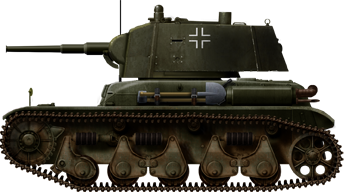
Tanks Encyclopedia’s rendition of the R35 mit T-26 Turm. The colors are speculative.
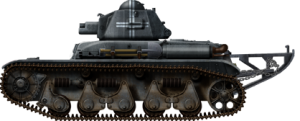
For comparison, a fairly typical Panzerkampfwagen 35R 731(f) with tail, France, fall 1940.
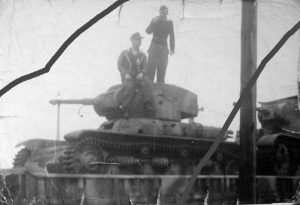
R35/T-26 with an M1935 turret. It appears as though it is being transported by rail along with a T-26. The nationality of the soldiers is unclear, but the vehicle has been attributed to Romania. Note: the image appears to have been watermarked.
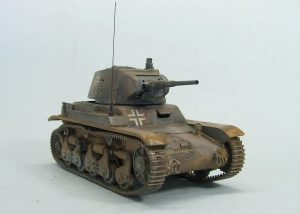
A scale model of the R35/T-26 showing the opposite angle to the original photo. Colors are speculative only. The sheer attention to detail on this model is astounding. Credits: Armorama user “Panzerserra”, 2011. Available here.
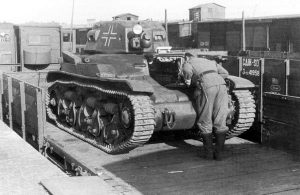
A Renault R35 in service with the 7th SS Volunteer Mountain Division Prinz Eugen. There appears to be a radio antenna visible on the rear of the hull just on the left. As taken from “Prinz Eugen Balkans archive” by Fraser Gray and Bruce Crosby.
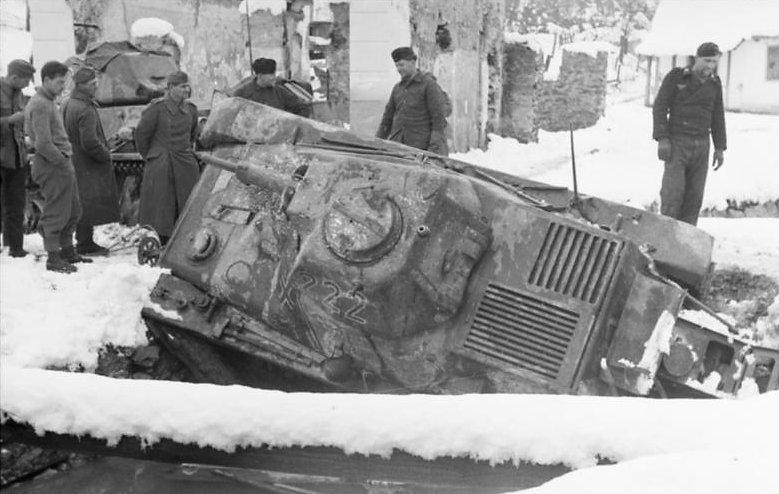
Often easily mistaken for an R35, this is a German Hotchkiss H39 stuck in a ditch, Yugoslavia, circa winter 1941/2. The radio antenna can be seen at the rear of the hull on the right side. The radio antenna was closer to the front on the R35/T-26 conversion, it is unclear if location of the radio mount was standardized.
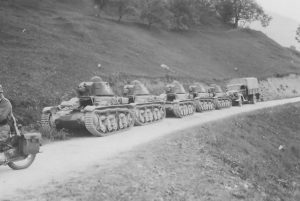
A column of Panzerkampfwagen 35R 731(f)s, location and date unknown. Possibly Yugoslavia.
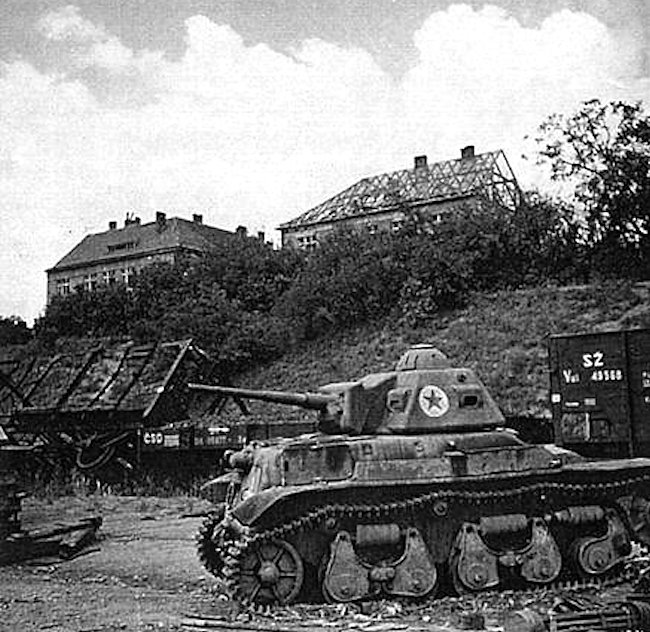
Between 1943 and 1944, thirty-six Romanian R35s were converted by Atelierele Leonida with a high-velocity Soviet 45 mm (1.77 in) gun jammed in the turret, and were renamed “Vânătorul de Care R35”. Due to the few known photos of this rare conversion, and the fact that it has a 45mm gun, it may have confused some sources, and led them to believe that they are the same thing, when they are not.
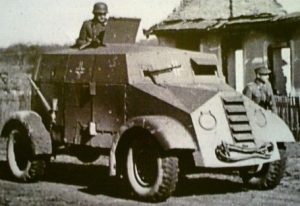
An improvised armored car that is believed to be based on a commercial Morris CS8. It was reported to be in support of, it not part of, the 7th SS Volunteer Mountain Division Prinz Eugen in Yugoslavia. It was also reportedly captured near Ljubljana in May, 1945. This is circumstantial evidence to suggest that the Prinz Eugen, or a similar/nearby unit might have had access to field conversion equipment necessary for the T-26/R35 conversion.
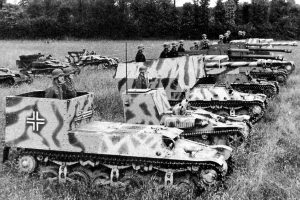
Four 155th Panzer Artillery Regiment, 21st Panzer Division 10.5cm leFH-18/40 auf Geschuetzwagen Lorraine Schlepper(f) SPGs on parade in France 1944. There are three Renault UE chenillette tracked infantry supply tractors behind them. The vehicle at the front of the photograph is a Lorraine VBCP-38L (Voiture blindee de Chasseurs Portes), an armored personal carrier modified to be an improvised artillery observation vehicle. The second vehicle is a “Kleiner Funk-und Beobachtungspanzer auf Infanterie-Schlepper UE(f)” a small radio and observation vehicle based on an armored Renault UE chenillette chassis. (Baukommando Becker converted 40 Renault UEs to this specification. They replaced the rear ammunition and supplies transportation box with a lightly armoured structure for observation and radio equipment). The larger vehicle would have been the Battery Officer’s command vehicle and the smaller one would have been used as an observation post vehicle – being small it would be fairly easy to conceal. This is an example of how beutepanzers were converted into artillery observation and radio vehicles, which is what the R35/T-26 might be. However, it must be noted that there is no proof that this is what the R35/T-26 was, and it also seems like a much hastier and cruder conversion that the ones in the above photo.
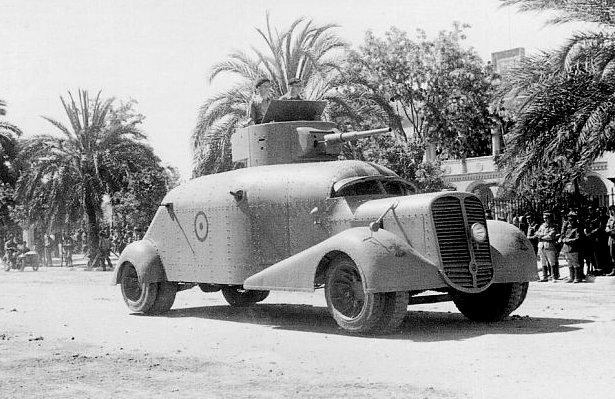
A Hispano Suiza MC-36 with a T-26 M1935 turret. This vehicle originally had a fairly large, dome-shaped turret featuring a Hotchkiss machine gun. A number of these vehicles were used by the Republicans, but were captured by the Nationalists, probably somewhere between Madrid and Seville. It was reportedly used as the command vehicle for Agrupacion de Carros del Sur.

6 replies on “Panzerkampfwagen 35R 731(f) mit T-26 Turm”
ID BE LOST WITHOUT THIS SITE.
This site is my heart. Without it, I would’ve been long dead. Thank you guys over at Tank Encyclopedia.com. Keep the boys coming!
Curious… You don’t have an article for the Carro Armato M15/42.
We truly don’t as of yet. There are still bits and pieces missing from our Encyclopedia, which is why we release three new articles every week.
If you want to help us get articles out quicker, consider donating on Patreon or through Paypal!
One theory perhaps not considered for the Panzerkampfwagen 35R 731(f) mit T-26 Turm is that is was converted by 3 Kp. Pz.Jg.Abt. 563 when they converted 10 T26 into 7,5cm Pak 97/98(f) auf Pz. 740 (r) in October 1943 they then had 10 T26 turrets left over! perhaps they used 1 or more to convert, R35 or R35 munition sclepper into a tank. I believe T26 7.5cm were fighting in Estonia in 1944 in the battle of Tehumardi and these would have been useful in that theartre.
A French tank with a Soviet turret used by the Germans – one of the more unusual “mash-ups” of WW2 AFVs.